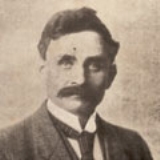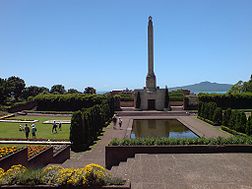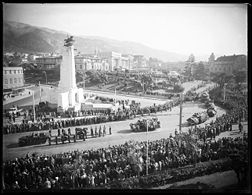
Michael Joseph Savage
Encyclopedia
Michael Joseph Savage (23 March 1872 – 27 March 1940) was the first Labour
Prime Minister of New Zealand
.
d to New Zealand in 1907. There he worked in a variety of jobs, as a miner, flax-cutter and storeman, before becoming involved in the union
movement. Savage initially opposed the formation of the 1910 New Zealand Labour Party as he viewed the grouping as insufficiently socialistic. Instead he became the chairman of the New Zealand Federation of Labour, known as the "Red Feds".
Savage unsuccessfully stood as the Socialist candidate for Auckland Central. During World War I he opposed conscription
, arguing that the conscription of wealth should precede the conscription of men. After the war the voters of the Auckland West
electorate put Savage into Parliament as a Labour member in the 1919 general election. He became one of eight Labour Members of Parliament, and in due course became the party leader following the death of Harry Holland
in 1933. He helped engineer the Labour/Ratana
alliance (formalised in 1936).

 During the depression
During the depression
, Savage toured the country, and became an iconic figure. An excellent speaker, he became the most visible politician in the land, and led Labour to victory in the 1935 election
. Along with the Premiership he appointed himself the position of Minister of Foreign Affairs and Minister of Maori Affairs. The first Labour government swiftly proved popular and easily won the 1938 general election
with an increased popular mandate. Savage, suffering from cancer of the colon at the time, had delayed seeking treatment to participate in the election campaign. He died from the cancer in 1940.
Savage led the country into World War II, officially declaring war on Nazi Germany
on 3 September 1939, just hours after Britain. Unlike Australia, which felt obligated to declare war, as it too had not ratified the Statute of Westminster
, New Zealand did so as a sign of allegiance to Britain, and in recognition of Britain's abandoning its former appeasement of the dictators, a policy that New Zealand had opposed. This led to Prime Minister Savage declaring (from his bed) two days later that:
Savage brought an almost religious fervour to his politics. This, and his death while in office, has made him become something of an iconic figure to the Left. The architect of the welfare state
(see Social welfare in New Zealand
), his picture reportedly hung in many Labour supporters' homes. Savage rejected rationalism
during later life and returned to his Catholic roots. His state funeral
included a Requiem Mass celebrated at the Basilica of the Sacred Heart, Hill St, Wellington
before his body was taken amidst general and public mourning by train to Auckland where he was interred initially in a temporarily adapted harbour defence gun installation. He was soon after removed to a side chapel of St Patrick's Cathedral
in Auckland, while a national competition was announced, decided, and the winning design of the monumental tomb and memorial gardens at Bastion Point constructed, forming his permanent resting site.
While younger generations have less awareness of him, many older New Zealanders continue to revere him.
from 1908 until he died. Alf came to New Zealand in 1894 on the ship Wairarapa which was wrecked on Great Barrier Island
, and helped in the rescue of a girl. Savage also served as the patron of the New Zealand Rugby League
.
Savage lies buried at Bastion Point
on Auckland
's Waitemata Harbour
waterfront in the Savage Memorial, a clifftop mausoleum
crowned by a tall minaret
, and fronted by an extensive memorial garden and reflecting pool
.
New Zealand Labour Party
The New Zealand Labour Party is a New Zealand political party. It describes itself as centre-left and socially progressive and has been one of the two primary parties of New Zealand politics since 1935....
Prime Minister of New Zealand
Prime Minister of New Zealand
The Prime Minister of New Zealand is New Zealand's head of government consequent on being the leader of the party or coalition with majority support in the Parliament of New Zealand...
.
Early life
Born in Tatong, Victoria, Australia, Savage first became involved in politics while working in that state. He emigrateEmigrate
Emigrate is a heavy metal band based in New York, led by Richard Z. Kruspe, the lead guitarist of the German band Rammstein.-History:Kruspe started the band in 2005, when Rammstein decided to take a year off from touring and recording...
d to New Zealand in 1907. There he worked in a variety of jobs, as a miner, flax-cutter and storeman, before becoming involved in the union
Trade union
A trade union, trades union or labor union is an organization of workers that have banded together to achieve common goals such as better working conditions. The trade union, through its leadership, bargains with the employer on behalf of union members and negotiates labour contracts with...
movement. Savage initially opposed the formation of the 1910 New Zealand Labour Party as he viewed the grouping as insufficiently socialistic. Instead he became the chairman of the New Zealand Federation of Labour, known as the "Red Feds".
Socialist origins
In the 1911 general electionNew Zealand general election, 1911
The New Zealand general election of 1911 was held on Thursday, 7 and 14 December in the general electorates, and on Tuesday, 19 December in the Māori electorates to elect a total of 80 MPs to the 18th session of the New Zealand Parliament...
Savage unsuccessfully stood as the Socialist candidate for Auckland Central. During World War I he opposed conscription
Conscription
Conscription is the compulsory enlistment of people in some sort of national service, most often military service. Conscription dates back to antiquity and continues in some countries to the present day under various names...
, arguing that the conscription of wealth should precede the conscription of men. After the war the voters of the Auckland West
Auckland West
The former New Zealand Parliamentary electorate on the western outskirts of Auckland, was known as West Auckland from 1984 to 1993. The earlier electorates were known as City of Auckland West from 1861 to 1890, and then Auckland West from 1905 to 1946.-History:The "City of Auckland West" electorate...
electorate put Savage into Parliament as a Labour member in the 1919 general election. He became one of eight Labour Members of Parliament, and in due course became the party leader following the death of Harry Holland
Harry Holland
Henry Edmund Holland was a New Zealand politician and unionist. He was the first leader of the New Zealand Labour Party.-Early life:...
in 1933. He helped engineer the Labour/Ratana
Ratana
The Rātana movement is a Māori religion and pan-tribal political movement founded by Tahupōtiki Wiremu Rātana in early 20th century New Zealand...
alliance (formalised in 1936).
Prime Minister


Great Depression
The Great Depression was a severe worldwide economic depression in the decade preceding World War II. The timing of the Great Depression varied across nations, but in most countries it started in about 1929 and lasted until the late 1930s or early 1940s...
, Savage toured the country, and became an iconic figure. An excellent speaker, he became the most visible politician in the land, and led Labour to victory in the 1935 election
New Zealand general election, 1935
The 1935 New Zealand general election was a nationwide vote to determine the shape of the New Zealand Parliament's 25th term. It resulted in the Labour Party's first electoral victory, with Michael Joseph Savage becoming the first Labour Prime Minister...
. Along with the Premiership he appointed himself the position of Minister of Foreign Affairs and Minister of Maori Affairs. The first Labour government swiftly proved popular and easily won the 1938 general election
New Zealand general election, 1938
The 1938 New Zealand general election was a nationwide vote to determine the shape of the New Zealand Parliament's 26th term. It resulted in the governing Labour Party being re-elected, although the newly-founded National Party gained a certain amount of ground.-Background:The Labour Party had won...
with an increased popular mandate. Savage, suffering from cancer of the colon at the time, had delayed seeking treatment to participate in the election campaign. He died from the cancer in 1940.
Savage led the country into World War II, officially declaring war on Nazi Germany
Nazi Germany
Nazi Germany , also known as the Third Reich , but officially called German Reich from 1933 to 1943 and Greater German Reich from 26 June 1943 onward, is the name commonly used to refer to the state of Germany from 1933 to 1945, when it was a totalitarian dictatorship ruled by...
on 3 September 1939, just hours after Britain. Unlike Australia, which felt obligated to declare war, as it too had not ratified the Statute of Westminster
Statute of Westminster 1931
The Statute of Westminster 1931 is an Act of the Parliament of the United Kingdom. Passed on 11 December 1931, the Act established legislative equality for the self-governing dominions of the British Empire with the United Kingdom...
, New Zealand did so as a sign of allegiance to Britain, and in recognition of Britain's abandoning its former appeasement of the dictators, a policy that New Zealand had opposed. This led to Prime Minister Savage declaring (from his bed) two days later that:
With gratitude for the past and confidence in the future we range ourselves without fear beside Britain. Where she goes, we go; where she stands, we stand. We are only a small and young nation, but we march with a union of hearts and souls to a common destiny.
Savage brought an almost religious fervour to his politics. This, and his death while in office, has made him become something of an iconic figure to the Left. The architect of the welfare state
Welfare state
A welfare state is a "concept of government in which the state plays a key role in the protection and promotion of the economic and social well-being of its citizens. It is based on the principles of equality of opportunity, equitable distribution of wealth, and public responsibility for those...
(see Social welfare in New Zealand
Social welfare in New Zealand
Social welfare has long been an important part of New Zealand society and a significant political issue. It is concerned with the provision by the state of benefits and services. Together with fiscal welfare and occupational welfare, it makes up the social policy of New Zealand.Social welfare in...
), his picture reportedly hung in many Labour supporters' homes. Savage rejected rationalism
Rationalism
In epistemology and in its modern sense, rationalism is "any view appealing to reason as a source of knowledge or justification" . In more technical terms, it is a method or a theory "in which the criterion of the truth is not sensory but intellectual and deductive"...
during later life and returned to his Catholic roots. His state funeral
State funeral
A state funeral is a public funeral ceremony, observing the strict rules of protocol, held to honor heads of state or other important people of national significance. State funerals usually include much pomp and ceremony as well as religious overtones and distinctive elements of military tradition...
included a Requiem Mass celebrated at the Basilica of the Sacred Heart, Hill St, Wellington
Sacred Heart Cathedral, Wellington
The Metropolitan Cathedral of the Sacred Heart and of Saint Mary His Mother, better known as Sacred Heart Cathedral, is a Roman Catholic cathedral on Hill Street, Thorndon in Wellington, New Zealand. It is the cathedral of the Archbishop of Wellington...
before his body was taken amidst general and public mourning by train to Auckland where he was interred initially in a temporarily adapted harbour defence gun installation. He was soon after removed to a side chapel of St Patrick's Cathedral
St Patrick's Cathedral, Auckland
The Cathedral of St Patrick and St Joseph is the Cathedral of the Catholic Bishop of Auckland.-Origins:...
in Auckland, while a national competition was announced, decided, and the winning design of the monumental tomb and memorial gardens at Bastion Point constructed, forming his permanent resting site.
While younger generations have less awareness of him, many older New Zealanders continue to revere him.
Death and commemoration
He was a life-long bachelor, and lived with Alf and Elizabeth French in AucklandAuckland
The Auckland metropolitan area , in the North Island of New Zealand, is the largest and most populous urban area in the country with residents, percent of the country's population. Auckland also has the largest Polynesian population of any city in the world...
from 1908 until he died. Alf came to New Zealand in 1894 on the ship Wairarapa which was wrecked on Great Barrier Island
Great Barrier Island
Great Barrier Island is a large island of New Zealand, situated to the north-east of central Auckland in the outer Hauraki Gulf. With an area of it is the fourth-largest island of New Zealand's main chain of islands, with its highest point, Mount Hobson, rising...
, and helped in the rescue of a girl. Savage also served as the patron of the New Zealand Rugby League
New Zealand Rugby League
The New Zealand Rugby League is the governing body for the sport of rugby league football in New Zealand. The NZRL was founded on the 25 April 1910 in preparation for a tour of Great Britain that same year....
.
Savage lies buried at Bastion Point
Bastion Point
Bastion Point is a coastal piece of land in Orakei, Auckland, New Zealand, overlooking the Waitemata Harbour. The area has significance in New Zealand history for its role in 1970s Māori protests against forced land alienation by non Māori New Zealanders.-History:The land was occupied by Ngāti...
on Auckland
Auckland
The Auckland metropolitan area , in the North Island of New Zealand, is the largest and most populous urban area in the country with residents, percent of the country's population. Auckland also has the largest Polynesian population of any city in the world...
's Waitemata Harbour
Waitemata Harbour
The quite famous Waitemata Harbour is the main access by sea to Auckland, New Zealand. For this reason it is often referred to as Auckland Harbour, despite the fact that it is only one of two harbours surrounding the city, and is crossed by the Auckland Harbour Bridge. The Waitemata forms the north...
waterfront in the Savage Memorial, a clifftop mausoleum
Mausoleum
A mausoleum is an external free-standing building constructed as a monument enclosing the interment space or burial chamber of a deceased person or persons. A monument without the interment is a cenotaph. A mausoleum may be considered a type of tomb or the tomb may be considered to be within the...
crowned by a tall minaret
Minaret
A minaret مناره , sometimes مئذنه) is a distinctive architectural feature of Islamic mosques, generally a tall spire with an onion-shaped or conical crown, usually either free standing or taller than any associated support structure. The basic form of a minaret includes a base, shaft, and gallery....
, and fronted by an extensive memorial garden and reflecting pool
Reflecting pool
A reflecting pool or reflection pool is a water feature found in gardens, parks, and at memorial sites. It usually consists of a shallow pool of water, undisturbed by fountain jets, for a calm reflective...
.
External links
from the Dictionary of New Zealand BiographyDictionary of New Zealand Biography
The Dictionary of New Zealand Biography contains biographies for over 3,000 New Zealanders. It is available in both English and Maori. All volumes of the Dictionary of New Zealand Biography are available online....

